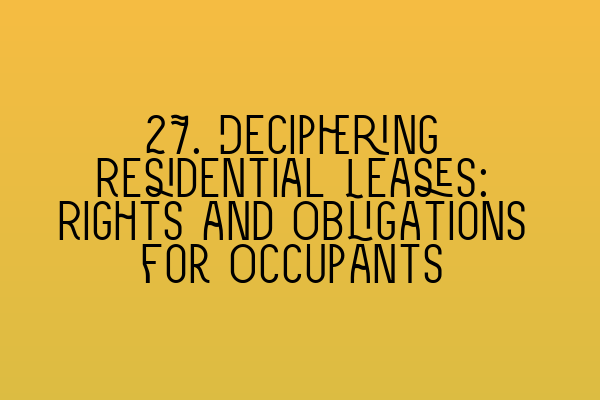Deciphering Residential Leases: Rights and Obligations for Occupants
Welcome to another informative blog post from SQE Property Law & Land Law! In today’s edition, we will be diving into the complex world of residential leases and exploring the rights and obligations that come with occupying a leased property. Whether you are a tenant or a landlord, understanding your legal rights and responsibilities is crucial for a harmonious and successful tenancy.
Before we dive in, we invite you to check out our related articles on SQE practice exam questions, SQE practice mocks, SQE preparation courses, and the SRA SQE exam dates. These resources will help you enhance your knowledge and prepare for your future as a legal professional.
Now, let’s get started!
1. What is a Residential Lease?
A residential lease is a legally binding document that outlines the terms and conditions of a rental agreement between a landlord and a tenant. It establishes the rights and obligations of both parties and provides a framework for their relationship throughout the tenancy.
2. Essential Elements of a Lease
To better understand the rights and obligations associated with a residential lease, let’s take a closer look at its essential elements:
a. Parties Involved: The lease must clearly identify the parties involved, namely the landlord and the tenant. This ensures that their respective obligations and responsibilities are enforceable.
b. Property Description: The lease should provide a detailed description of the rented property, including its address and any specific boundaries or limitations.
c. Rent Amount and Payment Terms: The lease must specify the agreed-upon rent amount, as well as the frequency and method of payment. It should also include any provisions regarding rent increases.
d. Tenancy Period: The lease should indicate the duration of the tenancy, whether it is a fixed-term lease or a periodic tenancy. This information is crucial for both the landlord and the tenant.
3. Rights and Obligations of Occupants
a. Tenant’s Rights: As a tenant, you have certain rights that are protected by law. These include the right to quiet enjoyment of the property, the right to a safe and habitable living environment, and the right to privacy. Understanding and asserting these rights is essential for a positive tenancy experience.
b. Tenant’s Obligations: Alongside their rights, tenants also have obligations to fulfill. These typically include paying rent on time, keeping the property clean and in good condition, and adhering to any rules or restrictions outlined in the lease agreement.
c. Landlord’s Rights: Landlords have rights that protect their property and ensure a smooth tenancy. These rights encompass the right to receive rent payments, the right to perform necessary repairs and maintenance, and the right to take legal action if the tenant breaches their obligations.
d. Landlord’s Obligations: Like tenants, landlords also have obligations to fulfill. These may include providing a safe and habitable environment, conducting necessary repairs and maintenance, and respecting the tenant’s privacy.
4. Resolving Disputes
Despite best intentions and efforts, disputes can sometimes arise between landlords and tenants. In such cases, it is important to address the issue promptly and seek a fair resolution. Taking legal action should be a last resort, as it can be expensive and time-consuming for all parties involved. Mediation and arbitration are often recommended as alternative dispute resolution methods.
In Conclusion
Deciphering the rights and obligations associated with residential leases can be a complex task. However, it is essential for both tenants and landlords to understand their legal rights and responsibilities to ensure a harmonious tenancy. By familiarizing yourself with the essential elements of a lease and the rights and obligations of occupants, you can navigate the rental landscape with confidence.
Remember to consult our related articles on SQE practice exam questions and practice mocks, as well as our SQE preparation courses and the SRA SQE exam dates. These valuable resources will help you enhance your legal knowledge and achieve success in your future career.
Thank you for joining us on this journey of unraveling the intricacies of residential leases. Stay tuned for more insightful content from SQE Property Law & Land Law!
Disclaimer: The information provided in this blog post is for general informational purposes only and should not be considered legal advice. For specific legal questions and concerns, please consult with a qualified solicitor.
